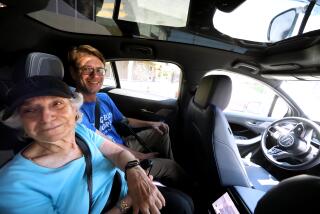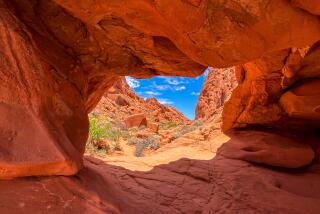Analyst sees more of future with technology from past
LAS VEGAS — When Roger Kay pulls up at a casino, people notice. That’s because he’s on a bicycle.
The cool desert wind whistling through his salt-and-pepper beard, Kay weaved past the stretch limos, Hummers and taxis that fill this city’s streets, then locked his fire-engine red Cannondale mountain bike in an alcove. The neon-yellow ankle bands, gloves and sunglasses disappeared into his backpack as he strode toward the Sands Expo and Convention Center.
By the time he popped out his silver hand-held device and slipped on his glasses, he looked every inch the nerdy technology analyst he is.
“A bike gives me freedom,” said Kay, 54. “I’m el capitan.”
The Consumer Electronics Show, which ran Monday to Thursday, is billed as America’s largest trade show, with 140,000 people flying in from across the world to ogle the latest TVs, camcorders, storage drives and high-tech gear.
It’s a nightmare to navigate. The show fills two convention centers, taking up 1.8 million square feet of exhibit space -- enough to fit 31 football fields. They’re lined with 6.5 miles of carpeted walkways that snake among 2,700 exhibits. Then there are the hundreds of private meetings and side events that take place in dozens of hotels along the Las Vegas Strip.
To get around, most attendees soon learn to submit themselves to a sea of taxi queues and bus lines. CES-goers this week had to build in as much as an hour of transit time between meetings.
Not Kay, president of Endpoint Technologies Associates in Wayland, Mass. The influential industry analyst turned to a technology invented more than 200 years ago to help transport him from meeting to meeting: the bicycle.
Bikes are about as rare on the Las Vegas Strip as penguins in the desert. But for the last five years, he has rented one to pedal past gridlocked cars and incredulous CES conventioneers to make his appointments. The bike shortens most of his commutes to less than 15 minutes, which lets him pack into one day more than a dozen 50-minute meetings -- many of them miles apart.
This year, Kay kept 39 appointments between Monday and Wednesday.
That’s what the show is all about. As an analyst, he likens himself to a bee buzzing around the exhibitors’ flowers, gathering information as he goes. It’s not just a cute analogy; it’s the lifeblood of the $170-billion U.S. consumer electronics industry.
For much of the year, those tinkering in consumer electronics are bound to cubicles and labs, working to develop thousands of devices that fill store shelves. Every January they pack their bags and head for Vegas, where they spend four days frantically meeting with as many people as they can.
In years past, CES has served as the launching pad for some watershed technologies, including compact discs, CD players, camcorders, DVDs and high-definition television. But it’s also the place where you can find robot beer coolers, an MP3 player that doubles as a stun gun and a toilet paper holder with an iPod dock.
For manufacturers, the show offers a chance to display their wares to retail-store buyers and other important customers. Entertainment executives flock here to scout out the devices that will play their music, movies or shows. Journalists and analysts come to soak up industry gossip and get the scoop on the latest and greatest gadgets.
“It’s about pressing the flesh with clients that you deal with all year over the phone,” Kay said. “CES is just a date and a city where everybody in the industry has agreed to be. People like me are reinforcing relationships with clients and maybe get some new ones.”
The first three years Kay attended, he rented cars and rode taxis like everyone else. “It was expensive, and I could never find parking,” he said.
So in 2004, he rented a bike. Kay had always been partial to that method of getting around. During his mid-20s, he quit his desk job at Motorola Inc., sold his house and just about everything in it and condensed his life into a 40-pound backpack. He spent several months biking across Europe with no particular agenda.
“I use it to explore,” he said of cycling. “Whenever I go to a new place, I always try to rent a bike. When you drive, you find yourself in a bubble, and you can’t hear or smell anything.”
That may cause sensory overload in Vegas, but biking gets him where he needs to go much faster than the other conventioneers.
At this year’s event, Kay spent five minutes riding from a meeting at the Residence Inn to another at the Flamingo Hotel. The two-mile trip would have taken half an hour had he waited for a taxi or walked.
From the Flamingo, Kay zipped up the Strip -- occasionally hopping onto the sidewalk to dodge buses and sneak around cars to make an appointment at the Sands. The Sands is nearly double the size of the Los Angeles Convention Center. But in this city, it’s considered cozy because it’s less than half the size of the Las Vegas Convention Center.
Parking a bike in Vegas isn’t easy, but over the years, Kay has discovered some of the best spots. He tucks it in remote corners or locks it at back entrances for employees, which occasionally have bike racks. At hotels, he slips a few extra dollars to the bellhop to keep an eye on it. He scours digital maps on Google Earth to suss out places to lock up his bike, along with shortcuts and side entrances that can help him shave off even more minutes of transit time.
For Kay, whose last vacation involved hiking through Costa Rican jungles, the bike ride also wakes him up after dull meetings indoors.
“My job involves sitting at a desk all day, so my idea of fun is anything but that,” he said. “In between appointments, I get fresh air and a little exercise.”
--
More to Read
Sign up for Essential California
The most important California stories and recommendations in your inbox every morning.
You may occasionally receive promotional content from the Los Angeles Times.










